Gardens don’t have to follow rigid rules—some of the most memorable outdoor spaces feel playful, unexpected, and full of charm. Whimsical garden ideas bring personality to every corner, blending color, texture, and quirky features that delight visitors and reflect your unique style. From upcycled planters to fairy lights woven through trees, these designs add visual interest without requiring a massive budget or expert skills. As more people seek joy and creativity in their surroundings, this trend continues to grow. In this guide, you’ll find approachable, fun, and creative ways to infuse character into your garden—no matter the size or setting.
Fairy Tale Pathways with Glow-in-the-Dark Pebbles

Twilight strolls gain an enchanting upgrade with garden paths lined in glow-in-the-dark pebbles. These luminous stones absorb sunlight throughout the day and emit a soft, magical glow by night, guiding footsteps with subtle radiance. Available in various hues, they can be layered between traditional pavers or scattered loosely along dirt or gravel trails to achieve a dreamy effect. This idea not only enhances safety but also adds a storybook charm to backyard spaces without relying on external electricity. Eco-friendly and low-maintenance, they’re ideal for whimsical gardens that come alive after sunset. Pair them with natural borders like moss, thyme, or miniature ferns for a textured finish. Placement near shaded arches, rustic benches, or fairy figurines heightens the fantasy ambiance. For best results, position the path where it can soak up direct sunlight during the day to ensure optimal nighttime visibility. Whether outlining a winding walkway or circling a central flower bed, these radiant stones bring both function and fantasy. They’re especially engaging for children and guests, encouraging exploration through the landscape after dark. For anyone curating a garden meant to surprise and delight, these pebbled trails offer one of the simplest yet most memorable ways to make it feel like stepping into a fairy tale.
Repurposed Vintage Furniture as Plant Displays
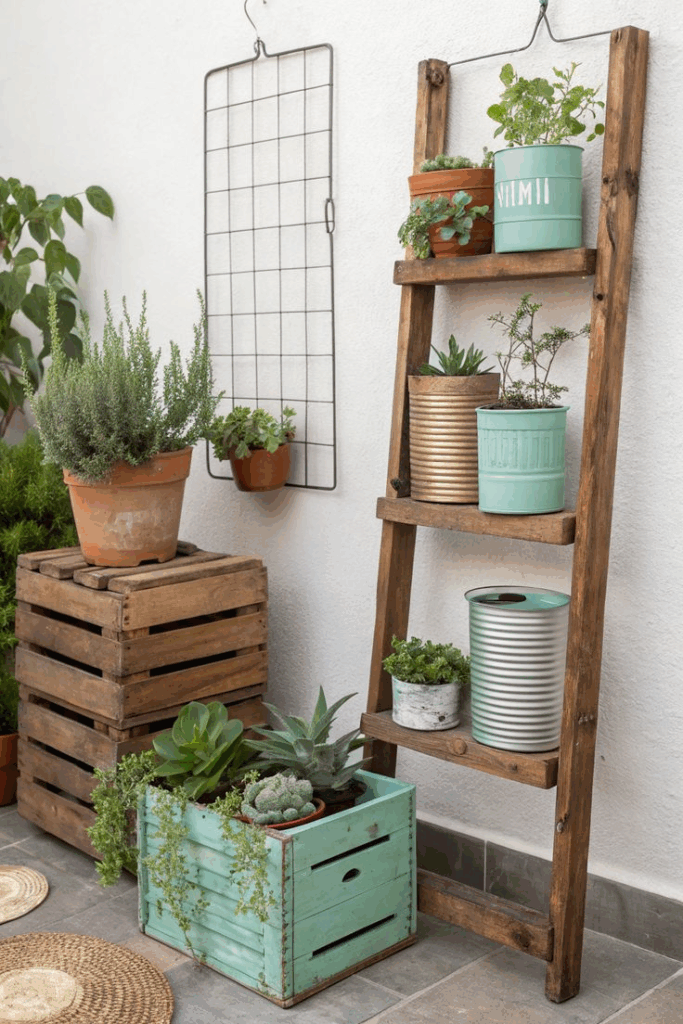
Antique furniture often collects dust in garages or flea markets, but outdoors, it finds fresh life as a whimsical plant display. Old dressers, chairs, ladders, and nightstands instantly become eye-catching garden features when creatively repurposed. Drawers can be pulled out at staggered angles, filled with trailing vines, colorful blooms, or herb clusters. A weathered vanity becomes an unexpected focal point when topped with overflowing pots and mirror glass aged to a gentle fog. These installations evoke nostalgia while encouraging sustainability. They also add vertical interest to flat garden beds, providing height variation for more dynamic layering. Rusted iron beds can support climbing roses, and open drawers are ideal for fast-draining succulents. Before placing furniture outdoors, it’s smart to treat wood with a water-resistant sealant or allow the natural aging process to enhance the rustic charm. Positioning them against fences or trees lends stability, and grouping several mismatched pieces in one area creates a shabby-chic garden vignette. These displays are particularly useful in cottage or eclectic gardens, where imperfection adds to the character. Beyond visual appeal, using repurposed furniture gives each item a second chance while keeping your garden layout imaginative and ever-evolving.
DIY Mushroom Garden Sculptures
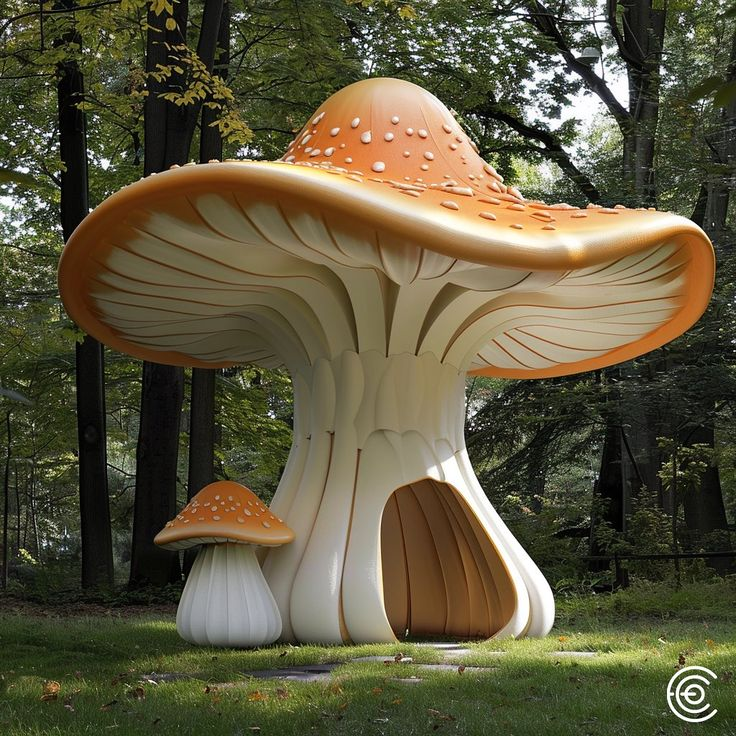
Handmade mushroom sculptures add playful detail and fantasy flair to shaded corners and garden beds. Using everyday materials such as terracotta pots, concrete, or recycled plastic bowls, these toadstool accents can be painted in vivid reds, oranges, and whites to mimic classic fairy tale fungi. When grouped in clusters or scattered beneath trees, they draw the eye and hint at hidden woodland worlds. This project invites creativity: use textured paints for realistic caps or glitter finishes for a magical shimmer. Some gardeners opt to craft them from hypertufa for durability, while others use wood stumps topped with upcycled salad bowls for a rustic twist. Size variety is key—taller mushrooms anchor the space, while smaller ones fill in gaps, mimicking natural clusters found in forests. For added personality, embellish with ladybug decals, faux moss, or tiny fairy figurines. These sculptures work especially well in woodland, fairy, or eclectic garden designs. They resist weather well, especially when sealed with a protective coat. Since they can be customized to any scale, DIY mushrooms also make engaging weekend projects for families. When integrated thoughtfully into your layout, they become enduring icons of garden whimsy, sure to charm visitors and spark curiosity in children and adults alike.
Hanging Lanterns with Solar-Powered Lights
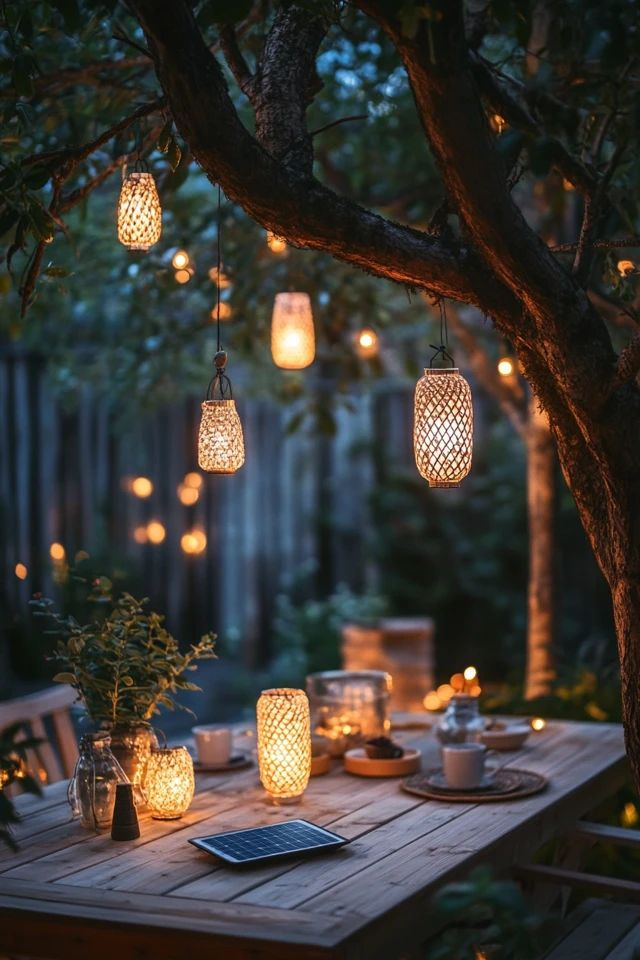
Suspended lights dancing in the breeze create instant enchantment in any backyard. By choosing solar-powered lanterns, you blend sustainability with visual charm, illuminating garden paths or seating areas without electrical wiring. These lanterns come in metal, paper, or glass designs, allowing for customization based on your preferred style—vintage, boho, or fantasy-inspired. During daylight, the solar panels charge quietly, and by nightfall, the garden glows with ambient warmth. Try stringing lanterns across tree branches, shepherd’s hooks, or pergolas to frame a cozy retreat. When used above flower beds or near water features, the reflection adds layered beauty. Maintenance is minimal—just occasional cleaning of panels and bulbs to maintain brightness. Colors can be coordinated with surrounding plantings or chosen in whimsical pastels for playful contrast. You can even mix and match shapes and heights to mimic floating fireflies or fairy lights. Because these lanterns recharge daily, they function reliably even in areas far from home power sources. Especially during evening garden parties or quiet twilight moments, solar lanterns become functional art pieces. Their gentle radiance not only improves visibility but contributes to a dreamlike setting, reinforcing the garden’s identity as a place where imagination and nature coexist.
Miniature Doorways on Tree Trunks

Whimsy unfolds when tiny doors peek out from the bases of mature trees, suggesting secret passageways to mythical worlds. These decorative touches can be handmade or purchased, and they attach directly to bark or base roots with adhesive hooks or screws. Styles range from rustic wood-carved designs to brightly painted doors complete with windows, knobs, and miniature accessories. Some gardeners go further, adding faux pathways leading up to the doors or placing mushroom figures, acorn baskets, or faux lanterns nearby. The placement should feel natural—slightly hidden but visible enough to invite discovery. Best suited for fairy gardens or spaces designed to delight children, these miniatures trigger storytelling and spark curiosity. Waterproofing helps the installations last across seasons, especially during monsoons or snow. Depending on the theme, doors can mimic woodland cottages, medieval castles, or steampunk vaults. When used across several trees, they form a “village” that transforms the yard into a living fantasy map. Though small in size, these details hold immense power in setting mood and sparking imagination. For garden lovers looking to go beyond traditional décor, miniature tree doors are a charming entry point into a playful, interactive landscape experience.
Colorful Painted Rock Caterpillars
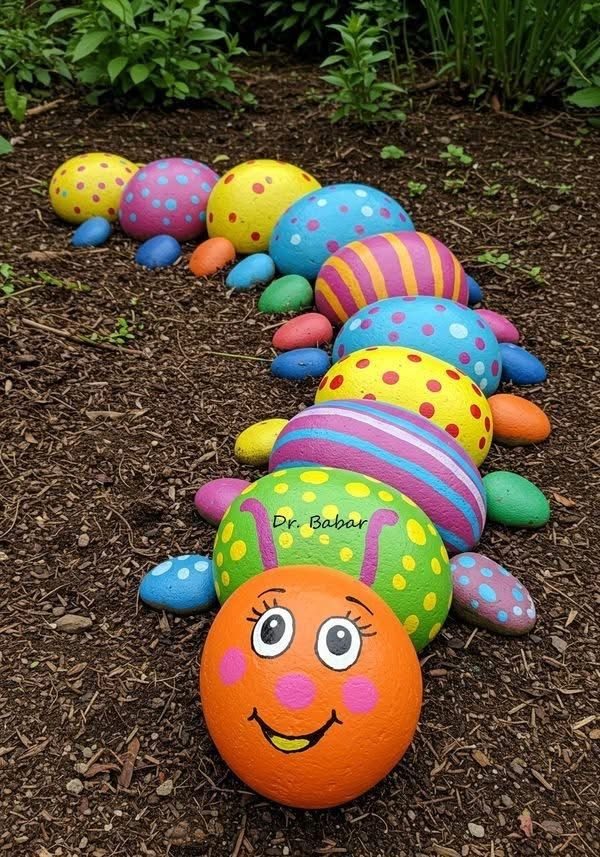
Clusters of painted stones arranged in curving lines easily mimic whimsical caterpillars that seem to crawl through garden beds. These fun, low-cost creations bring personality to plantings while offering a creative outlet for kids and adults alike. Each “segment” of the caterpillar is a smooth rock painted in vibrant colors, then sealed for weather resistance. A larger stone with hand-painted eyes and antennae becomes the cheerful face. Placement matters—nestle them beneath hostas, along edging, or peeking out from flower pots. They work especially well in children’s garden corners or near fairy installations. Involve kids by letting them paint individual segments in their favorite shades or patterns—polka dots, stripes, even glitter finishes. Acrylic paints offer bold coverage, and a spray sealant helps preserve the design across seasons. While caterpillars are most common, variations include ladybugs, bees, or even snakes made from similar techniques. These rock creatures are portable and easy to rearrange, perfect for evolving displays. Best of all, they reuse natural or discarded materials, making them sustainable additions. Over time, they become familiar characters that add personality to the garden. For those looking to merge art and horticulture in a lighthearted way, painted rock insects remain a crowd-pleasing choice.
Upcycled Teacup Bird Feeders

Vintage teacups take on new charm when suspended as bird feeders throughout your garden. This upcycled idea blends delicate design with practical support for feathered visitors. Choose floral porcelain or whimsical ceramic patterns to complement the garden’s aesthetic. Mounting options vary: attach cups to saucers with strong adhesive, then hang them from branches using wire or ribbon. Others glue the sets atop copper pipes for ground-based installations. Fill with birdseed or dried fruit to invite sparrows, finches, and chickadees to dine in style. The compact size encourages manageable refills while preventing waste. These feeders double as decor, offering pops of color and storytelling nostalgia among foliage. Ideal for cottage gardens or romantic-themed outdoor spaces, teacup feeders also provide a unique talking point for visitors. Rain drains easily, and a quick wipe keeps them clean seasonally. When displayed in clusters or varied heights, they resemble floating tea parties for the birds. Beyond functionality, these delicate feeders evoke a sense of care and creativity, making the garden not just a haven for plants, but for wildlife too. For gardeners seeking to integrate vintage elegance with purposeful detail, teacup bird feeders provide a memorable and environmentally thoughtful solution.
Whimsical Wind Chimes from Recycled Materials
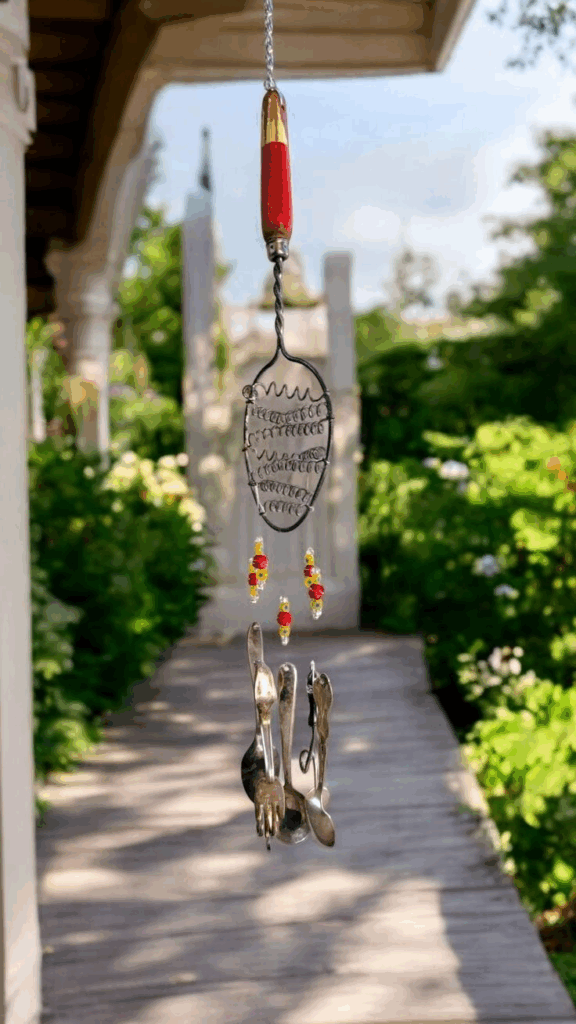
Unexpected melodies drift through garden air when wind chimes are crafted from repurposed objects. Old keys, spoons, driftwood, or even tin can lids become musical elements when suspended from string or fishing line. The charm lies in the imperfections—each set produces a unique soundscape shaped by material and breeze. Mount them from tree branches, pergolas, or porch beams where airflow is frequent. To add visual flair, paint or decorate the components in playful pastels or metallics. This project not only reduces waste but allows for artistic expression. It’s ideal for family crafting sessions or as gifts for fellow garden lovers. When clustered at varying lengths, they produce layered tones that invite pause and presence. Use durable string to ensure longevity, and coat metal pieces to avoid rust. Some gardeners choose to incorporate beads, shells, or tiny bells to vary the acoustics. As the garden grows and blooms shift, these recycled wind chimes remain ever-present, offering gentle auditory beauty. They’re especially effective in meditation nooks, fairy-themed areas, or entry points where they softly announce arrivals. With minimal cost and endless creative possibilities, these chimes give the garden a living voice, reflecting both the wind’s whim and the gardener’s personal style.
Garden Mirrors to Create Illusions of Space

Mirrors aren’t just for interiors—they work wonders outdoors when placed strategically in the garden. A properly framed mirror nestled among hedges or hung on a fence can visually double a space, reflect blooms, or mimic hidden gateways. Choose weatherproof or upcycled frames and ensure placement avoids direct sunlight to prevent glare or fire risk. Popular settings include shady corners or small patios where reflections enhance depth. For a magical touch, tilt the mirror slightly downward or surround it with ivy, moss, or floral garlands. The result evokes a sense of secret gardens and visual wonder. These installations are particularly effective in compact yards, where they introduce light and perceived size without physical expansion. Use oval, round, or ornate frames to suit your garden’s style—rustic, vintage, or storybook. When partially obscured by climbing vines or trellised plants, mirrors become windows to imagined spaces. Maintenance is simple: occasional cleaning and secure mounting. Avoid placing them near bird feeders to reduce the chance of collision. Whether used to amplify sunlight or frame a cherished plant display, mirrors offer high visual impact with low investment. They turn gardens into living galleries, where beauty exists not just in what’s planted but also in what’s reflected.
Stepping Stones with Hand-Painted Designs
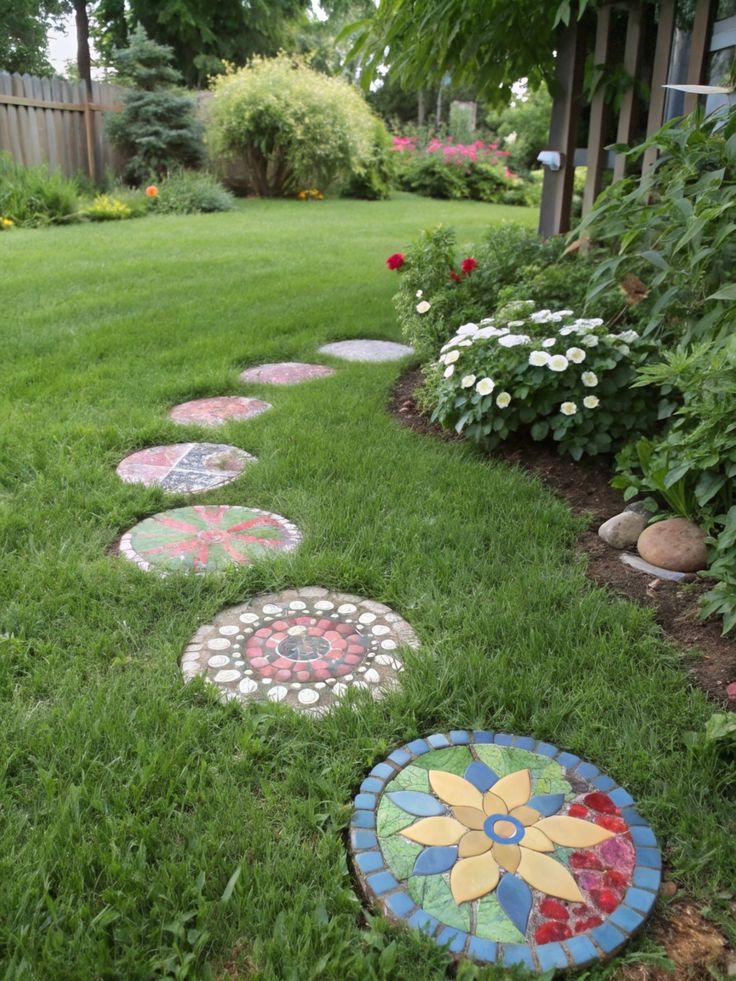
Functional meets imaginative when stepping stones are transformed into hand-painted works of art. Rather than plain pavers, opt for concrete or stone slabs painted with colorful patterns, floral motifs, mandalas, or whimsical characters. Each piece becomes a story beneath your feet, guiding visitors along paths with charm and creativity. Durable outdoor paints and weatherproof sealants ensure longevity, even through seasons of sun or rain. These stones serve both as walkways and artistic accents—ideal for gardens frequented by children or styled with a fantasy or cottagecore theme. You can personalize them with family handprints, inspirational quotes, or garden-related illustrations. Layout flexibility allows them to snake through flower beds, line vegetable patches, or lead to a secret bench. Their presence turns simple traversal into an experience. Grouped in odd numbers or layered with mulch or moss, the stones blend art with natural texture. Even single stone installations placed near focal points can catch the eye and enrich the narrative of the space. If you’re hosting garden tours or seasonal events, these painted details offer a conversation starter. With thoughtful placement and unique visuals, hand-painted stepping stones elevate garden paths into interactive galleries.
Topiary Animals Sculpted from Shrubs
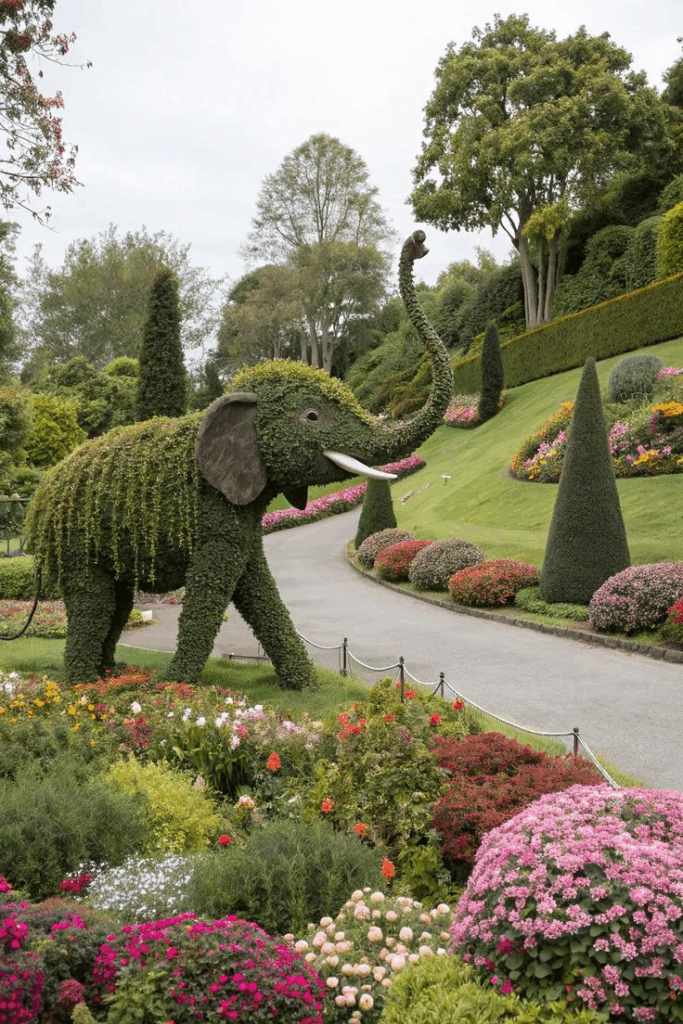
Greenery becomes sculpture when shrubs are clipped into charming animal forms. From playful rabbits to majestic peacocks, topiary animals turn ordinary hedges into fantastical figures that breathe personality into lawns and beds. Boxwood, privet, and yew are preferred for their dense, small leaves and responsive growth. Start with wire frames for beginners or freehand trimming for seasoned gardeners. Maintenance requires regular shaping, usually every few weeks during the growing season, to preserve defined silhouettes. Position your topiary creatures where they’ll stand out—near entryways, along central pathways, or as surprise elements peeking from garden corners. To enhance visibility, underplant with low-profile ground cover or mulch. These living sculptures thrive in whimsical, formal, or storybook garden settings and are especially loved by children. With time and care, they become statement features that evolve in form and detail. Lighting from below or behind can amplify their presence at night, turning them into nocturnal guardians. While creating topiaries requires patience, the reward is a garden that not only grows—but entertains. These creatures offer visual humor and charm, proving that with clippers and vision, even foliage can be coaxed into storytelling.
Hidden Gnome Villages Among Flower Beds

A touch of folklore hides beneath blooms when miniature gnome villages are tucked among flower beds. These pint-sized communities can include tiny homes, bridges, ladders, and shops nestled under leaves or beside stones. Designed for discovery, they enchant children and adults alike, encouraging exploration during garden strolls. Most setups use weatherproof resin or wood figures, but creative gardeners often DIY pieces using clay, bark, or found objects. The key is subtle placement—nestled beneath hostas, beside tree roots, or under garden benches, making them feel organically integrated. Some even include fairy mailboxes, signage, or seasonal accessories for added charm. Lighting with micro LEDs or glow pebbles boosts visibility in the evening and keeps the illusion alive after sunset. These villages thrive in cottage, woodland, or eclectic garden themes and serve as conversation starters during visits. They also encourage playful storytelling and imagination, especially among younger visitors. While they may seem purely decorative, these hidden worlds reflect a gardener’s attention to detail and love for whimsy. Over time, each gnome or structure adds to an evolving narrative that makes your garden uniquely magical and personal. For those who believe nature holds secrets, gnome villages whisper just loud enough to hear them.
Butterfly Houses Painted in Vibrant Colors
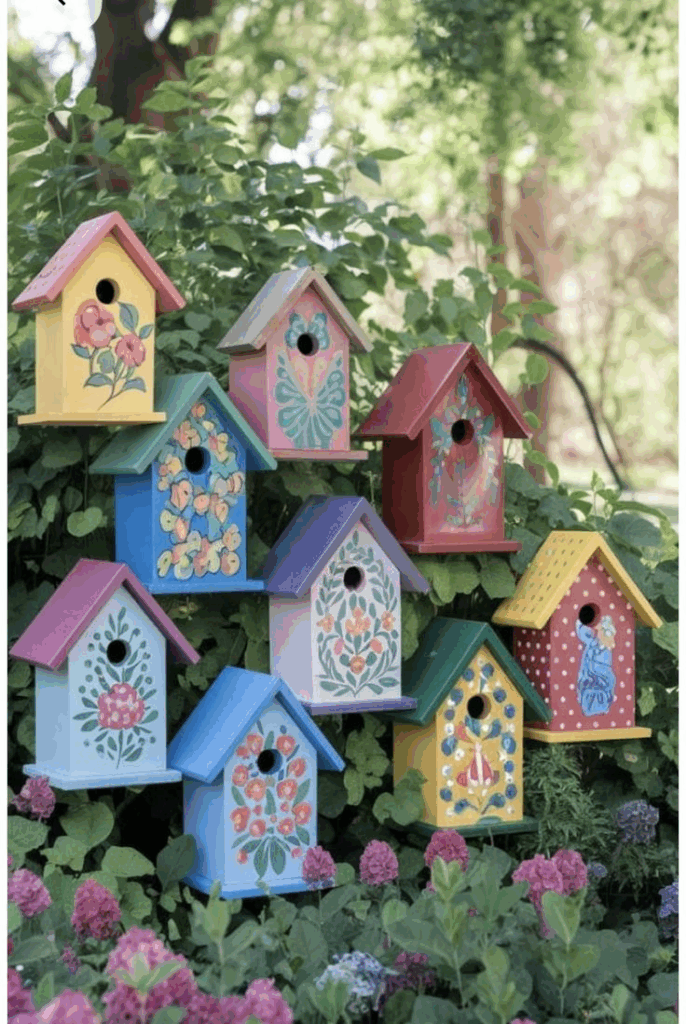
Gardens become more inviting to pollinators when butterfly houses offer safe shelter alongside blooms. These slim wooden structures mimic natural crevices where butterflies rest, especially during cold nights or rainy spells. When painted in bright hues—turquoise, coral, lemon—they not only attract attention but act as cheerful accents within beds or along fences. Position them in sunny, sheltered areas near nectar-rich flowers like coneflowers, milkweed, or zinnias to maximize occupancy. Vertical mounting mimics tree bark, and adding a few twigs or bark pieces inside helps butterflies feel secure. These houses work particularly well in butterfly gardens, children’s nature zones, or whimsical cottage spaces. They’re also educational tools, prompting conversations about pollinator health and native species. DIY versions allow for personal flair—use stencils, floral motifs, or polka dots for added visual charm. Weather-sealing extends durability, ensuring they remain garden-ready across seasons. While not every house may get inhabited immediately, their presence supports a pollinator-friendly landscape ethos. And even when unoccupied, they contribute playful energy to the environment. With minimal upkeep and high decorative value, these painted houses make butterfly conservation approachable, colorful, and visually joyful.
Hanging Baskets with Cascading Flowers
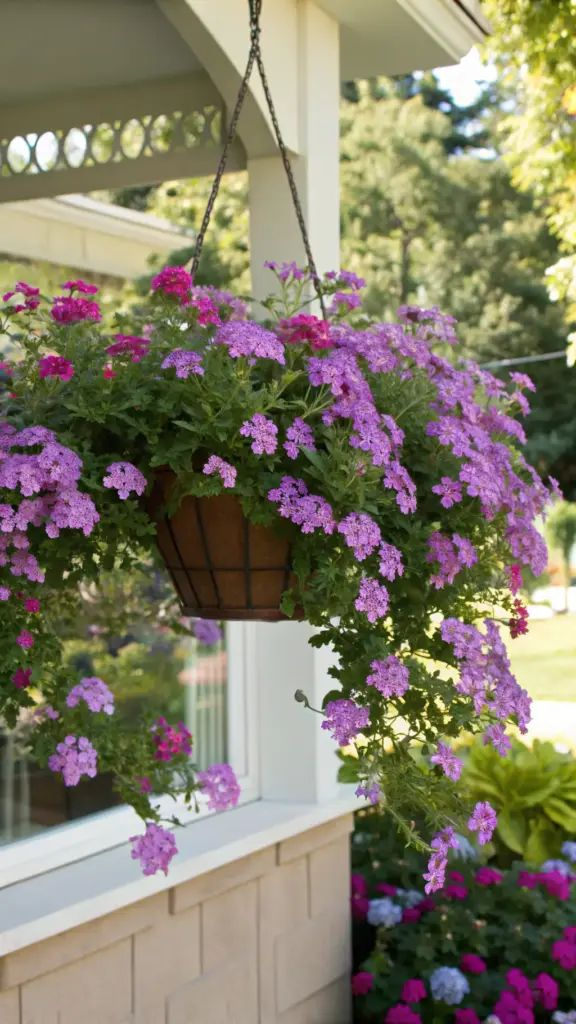
Tiers of color come to life when overflowing hanging baskets drape from arbors, hooks, or tree limbs. These dynamic accents extend vertical interest into the garden, especially when packed with trailing varieties like petunias, ivy geraniums, lobelia, or sweet potato vines. The visual impact lies in the cascade—blooms spill over the edges in waves, softening hard lines and introducing movement. Mixing colors and textures—pastels with punchy brights, ruffled petals with delicate leaves—adds depth and character. Lightweight baskets with coir liners provide breathability and drainage, while slow-release fertilizer pellets help sustain long-lasting displays. Placement near entryways, patios, or shaded seating spots makes them focal points in motion. These installations thrive in both traditional and whimsical garden styles. Watering regularly and rotating the baskets weekly ensures even growth and sun exposure. As the season progresses, flowers become fuller and more expressive, bringing life above eye level. They’re ideal for gardeners with limited ground space or those seeking to fill vertical gaps in their design. With little effort and the right plant pairings, hanging flower baskets deliver seasonal brilliance and fairytale beauty in every swaying bloom.
DIY Water Features Using Old Barrels

Repurposed wooden barrels make ideal bases for compact water features that hum with serenity. These upcycled containers hold liners, pumps, and aquatic plants while maintaining a rustic, storybook charm. Start with a half-barrel planter, line it with a pond insert or sealant, then install a small solar-powered fountain or bubbling pump. Add floating lilies, oxygenating plants, and smooth river stones to mimic a natural habitat. Surrounding the base with moss, bricks, or dwarf grasses blends the feature into your garden organically. The sound of trickling water invites calm and attracts pollinators like bees and butterflies. Place near seating nooks, garden entrances, or tucked within flower beds for unexpected delight. These water features are low-maintenance and ideal for small spaces or whimsical corners. They also offer habitat support for birds or frogs in urban environments. With seasonal updates—like fairy lights in winter or lotus blooms in summer—the barrel fountain evolves visually year-round. Beyond aesthetic charm, it fosters biodiversity and mindfulness. For gardeners seeking practical serenity with fairytale flair, few additions strike the balance like a bubbling barrel centerpiece.
